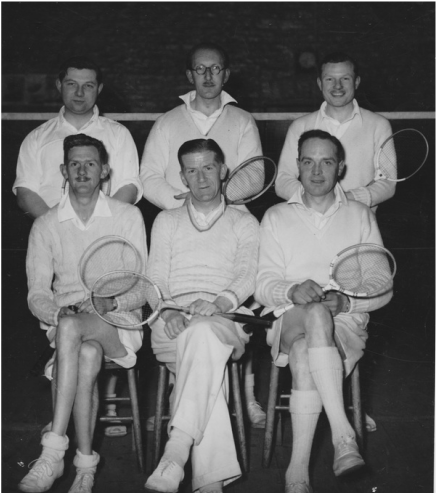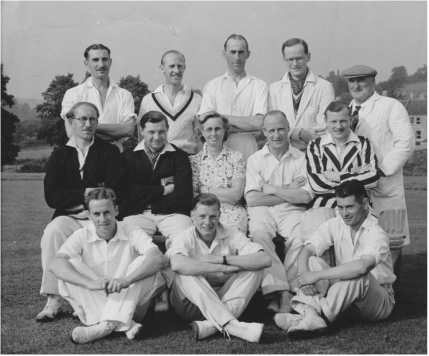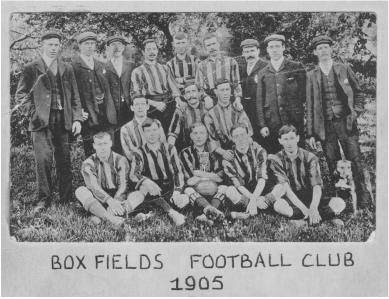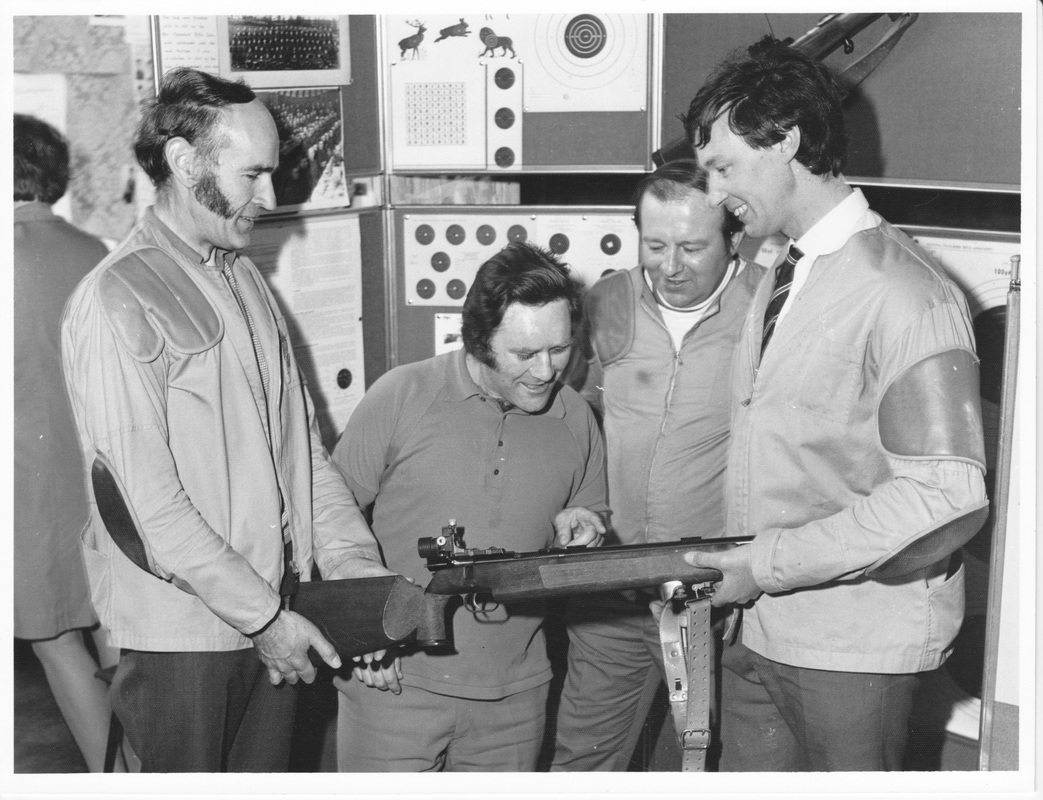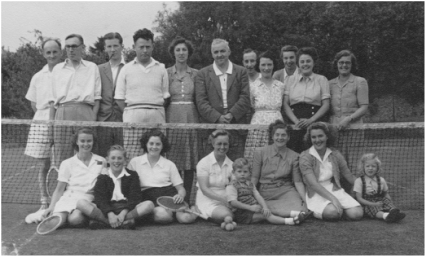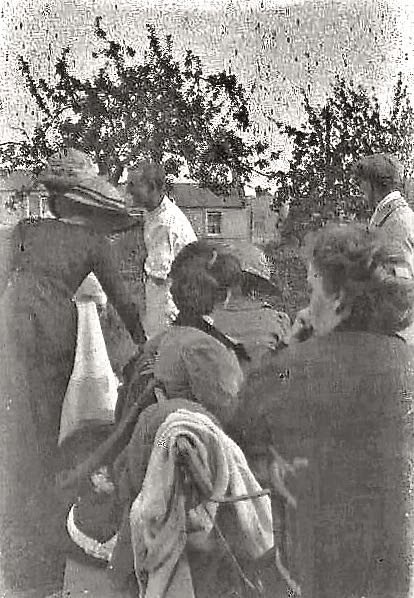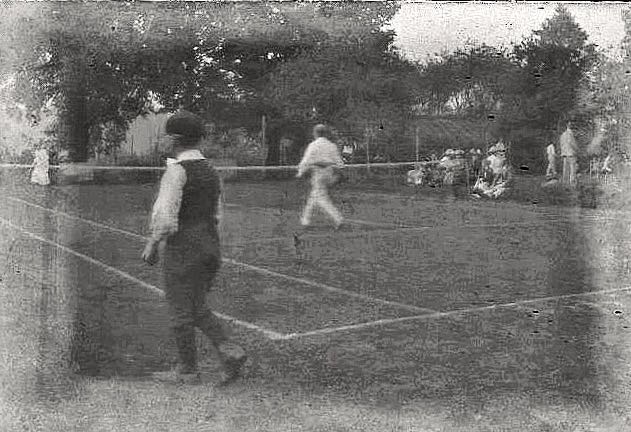Sports Clubs in Late Victorian Box Anna Grayson and Others July 2015
Many of our local and national sports clubs were founded in the late Victorian period. They satisfied many different objectives: greater concern with health; reformers' concerns to improve the lives of the working class; and a general shift in society caused by the move from rural lifestyles to an industrial economy with set working hours. The impact of these clubs was enormous and the extremes of wealth and poverty in Victorian society were partly reconciled through the number of organisations and clubs that encouraged mixed social involvement. The merging of Box Cricket Club and a team made up of Box Mechanics is one example.
|
Badminton Club
For one night a week a badminton club was held in the Bingham Hall (built in Chapel Lane in 1905). This was the first large recreational hall in the village and the start of popular indoor village activities. It wasn't really very suitable for badminton (see Bingham Hall).It was too small both in length and height and the shuttlecock got lost in the ceiling structures. A report of the club's match at the Bingham Hall on 17 November 1924 when the Box Club defeated Bath Banks by 42 points listed the following players: Mr E Vezey and Mrs J Bradfield; Mr R Browning and Miss F Lewis; Mrs Fido and Mr DI Lord; Mr and Mrs H Milsom. At one time (about 1969) the club had some very good players with one county player and one on the brink of the county team. Through the good offices of Mike Sloper of Wormwood Farm the Selwyn Hall was built in an unusual shape specifically with badminton in mind. [Article compiled from reminiscences of Anna Grayson] |
Cricket Club
The full story of Box Cricket Club has been told in Donald Bradfield's marvellous history, A Century of Village Cricket.
The official beginning of the club was in The Chequers on 27th April 1870. Cricket became established very early at Box, five years before the formation of Somerset CC and eight years before the first Test match.
For many years before there had been scratch sides involving local men and, in 1864, a Box man, FA Holworthy, had appeared in a match with WG Grace against an All England Eleven.
The full story of Box Cricket Club has been told in Donald Bradfield's marvellous history, A Century of Village Cricket.
The official beginning of the club was in The Chequers on 27th April 1870. Cricket became established very early at Box, five years before the formation of Somerset CC and eight years before the first Test match.
For many years before there had been scratch sides involving local men and, in 1864, a Box man, FA Holworthy, had appeared in a match with WG Grace against an All England Eleven.
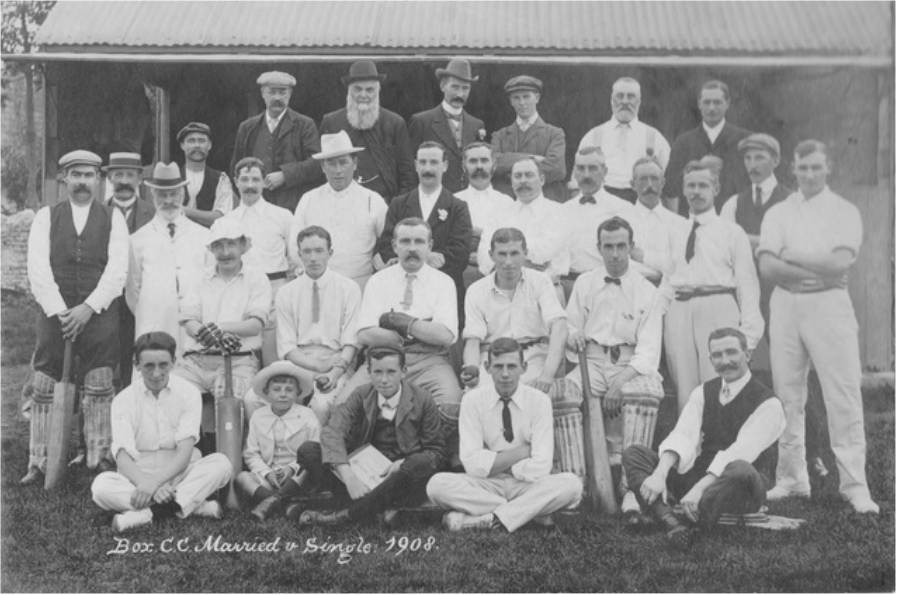
This amazing photo of Box Cricket Club Married Men against Single Men from 1908 shows Back row: Charlie Pearce (groundsman), unknown, Mr Weeks, Tom Lambert, Bob Ponting, Mr Short, Mr Hinton; Second row: Arthur Nowell, Mr Craddock, Gaffer Burroughs, Mr Moody, Mr Minty, Ben Vezey, Mr Laurence, Charlie Alexander, Dr JP Martin, Mr Peplar, Mr Vezey, Mr Milsom; Third row (seated): Herbie Benjamin, Steve McIlwraith, Sam Noble (wicket-keeper), Harry Milsom, Ted Vezey; Front row (on ground): JW Browning, Dick Shewering, H Lambert (scorer), Jim Browning, and Mr Alexander. (Photo courtesy Margaret Wakefield.)
Box Cricket Club was conscious of its importance from the beginning. It adopted the Mary-le-bone rules and the intention that all improper language be strictly avoided and that a fine of 3d on each occasion be inflicted for improper language or smoking during the playing of Matches. The club played at Middlehill or at Kingsdown until 1874 when it secured the Field called Farm Mead (now called the Rec) for the ensuing season at (a rental of) £12. It was a momentous decision that established cricket and a playing field right in the centre of the village.
Considerable work was undertaken to improve the condition of the pitch and there was a proposal to build a pavilion in 1895, the Silver Jubilee of the Cricket Club. But the field was still grazed by sheep and cattle belonging to Mr Daniell who had the grazing tenancy for Farm Mead. The team met twice a week and its players included WJ Burrows, the village schoolmaster, and Dr JP Martin.
Considerable work was undertaken to improve the condition of the pitch and there was a proposal to build a pavilion in 1895, the Silver Jubilee of the Cricket Club. But the field was still grazed by sheep and cattle belonging to Mr Daniell who had the grazing tenancy for Farm Mead. The team met twice a week and its players included WJ Burrows, the village schoolmaster, and Dr JP Martin.
In the early days cricket matches were often played by scratch teams from local organisations. A separate club, The Box Mechanics, also existed, playing at Kingsdown and representing the working man’s interests, under the care of the Rev GE Gardiner, vicar of Box after 1875 and his curate the Rev Albert Goodwin.[2]
|
Football Club
There was not one, but several, football clubs in the village. But we should not imagine that they started as organised games on a clearly marked pitch that we now have on the Lower Rec. Rather they were played on uneven fields in the hamlets where teams were very localised, such as the Box Fields team. We know that Box Rovers were playing 1909-10. By the 1960s there were several different Box teams: the Saturday and Sunday teams and also a Youth side. |
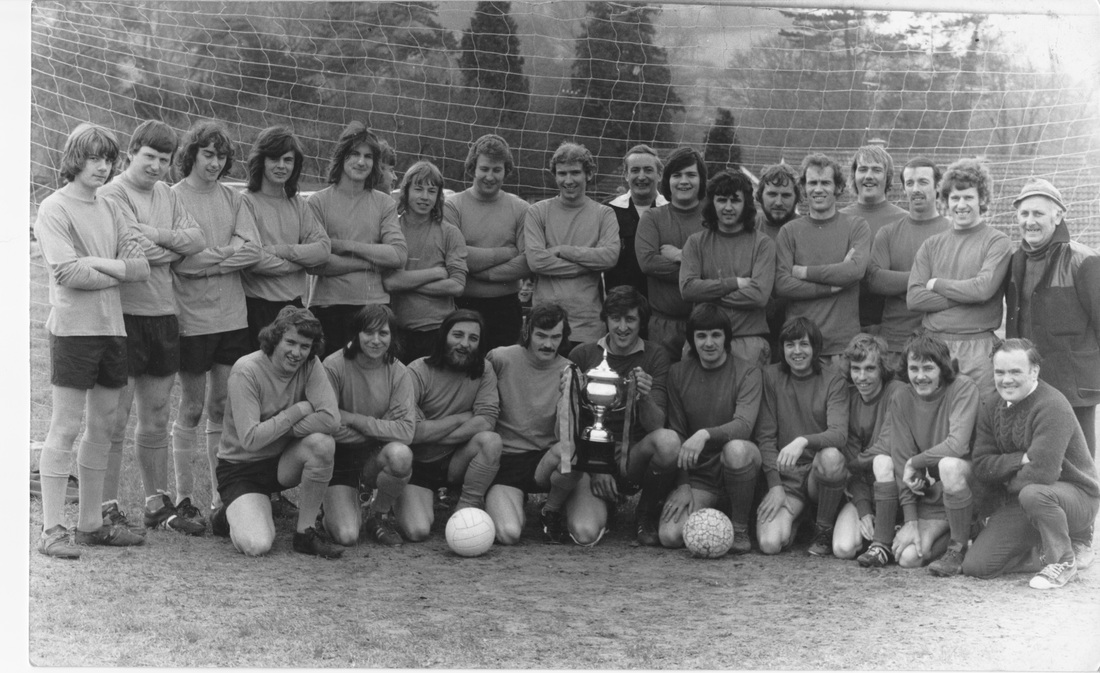
Some members of the Box teams in the Sawyer Cup: Left to Right, Back Row: A Gay, A Kerr, Jones, Williams, Andrews, G Cox, Perrett, Portnall, Cogswell, Perrett, Robson, McCarron, McComb, Trevor Gingell, Paddy Cole. Front Row: Jacobs, Phillips, Ford, Hater, Peplow, Hall, Rebbeck, Bourne, Cogswell. Photo courtesy Kevin Ford. Please contact us if you can provide more details.
Golf Club
Kingsdown Golf Club was formed in 1880 at a meeting at The Swan Inn, the oldest in Wiltshire and the second oldest in the South West after Westward Ho, Devon. It started as the Bath and Kingsdown Golf Club and, to attract members, it was described as distant 5 miles from Bath and a few minutes walk from Box Station, GWR main line.[3] In February 1890 the two clubs separated and Kingsdown existed in its on right.[4]
It had been formed by local gentlemen including Major Northey who granted a lease of the land to the club. This caused opposition from some locals and the newly-formed Box Parish Council, who consdered the area to be public common land. The story of this is recorded at First Battle of Kingsdown Common.
In 1911 Henry Kalbitzer, a German national, aged 73 was caretaker at Kingsdown Golf Club and Harry Painter at Kingsdown was the Greenkeeper on Golf Links.[5] The area was taken over for military training purposes during both World Wars
Until 1968 the course was only 12-hole. The Pope family who were renting Kingsdown Farm had to move their cow dung heap which was in the way of the 6-hole extension. Shortly after this the Popes sold land to the club to make the practice area and driving range and a perimeter track was made around the outside of the course.
Kingsdown Golf Club was formed in 1880 at a meeting at The Swan Inn, the oldest in Wiltshire and the second oldest in the South West after Westward Ho, Devon. It started as the Bath and Kingsdown Golf Club and, to attract members, it was described as distant 5 miles from Bath and a few minutes walk from Box Station, GWR main line.[3] In February 1890 the two clubs separated and Kingsdown existed in its on right.[4]
It had been formed by local gentlemen including Major Northey who granted a lease of the land to the club. This caused opposition from some locals and the newly-formed Box Parish Council, who consdered the area to be public common land. The story of this is recorded at First Battle of Kingsdown Common.
In 1911 Henry Kalbitzer, a German national, aged 73 was caretaker at Kingsdown Golf Club and Harry Painter at Kingsdown was the Greenkeeper on Golf Links.[5] The area was taken over for military training purposes during both World Wars
Until 1968 the course was only 12-hole. The Pope family who were renting Kingsdown Farm had to move their cow dung heap which was in the way of the 6-hole extension. Shortly after this the Popes sold land to the club to make the practice area and driving range and a perimeter track was made around the outside of the course.
|
Rifle Club - Phil Martin writes
The Rifle Club was a particular interest of mine from when I was about 14 and was coached by Graham Eyles, as secretary and Cecil Lambert as chairman. It was originally formed by Tom Bence and others to teach people to shoot during the Great War. It fell into disuse afterwards and then was revived about the time of the Second World War, chiefly by the efforts of Cecil Lambert. Cecil was a veteran of the trenches and, I believe, was awarded Mention in Dispatches in that conflict. Left to Right: Graham Eyles, Colin Worthing, Ken Edgell, and Philip Martin (photo courtesy PM) |
|
Tennis Club
In the years before tennis courts were established on the Rec, there were two grass courts and a hut on the A4 north-side. The club was known as The Tabby Park Tennis Club. At times matches were held there three times a week. The club was supported by many notable Box residents and in 1924 the committee comprised: Mr W Chaffey, captain; Miss L Inkpen, secretary; Miss G Eyles, treasurer; Mr Shaw-Mellor, vice president; and Dr JP Martin, president. Other members included: Dr Sweetapple-Horlock, Rev G Foster, Mr Kidstone, Mr F Goulstone, Mrs J Bradfield, Mrs L Prestland, Miss E Chaffey, Miss Ancel, Mr DT Lord and Mr D Bradfield. |
Later the tennis courts, which covered the area between Tregoney and The Keep, were sold for housing. The houses Courtlands and Lawn Villa still recall the former use of the area. After the development of the Tabby Park site some people played on private courts at Cheney Court or at a house near Thorny Pits. [Article compiled from reminiscences of Anna Grayson]
We welcome current clubs to tell us the story of their history and anyone who can add to the brief outlines above.
References
[1] See Hugh's full story at Box Swimming Club
[2] David Ibberson, The Vicars of St Thomas a Becket, Box, 1987, p.36
[3] Parish Magazine, Jan 2001
[4] http://www.kingsdowngolfclub.co.uk/history
[5] See Harry Painter's story of life at Kingsdown: http://www.choghole.co.uk/victor/victor1.htm
[1] See Hugh's full story at Box Swimming Club
[2] David Ibberson, The Vicars of St Thomas a Becket, Box, 1987, p.36
[3] Parish Magazine, Jan 2001
[4] http://www.kingsdowngolfclub.co.uk/history
[5] See Harry Painter's story of life at Kingsdown: http://www.choghole.co.uk/victor/victor1.htm

